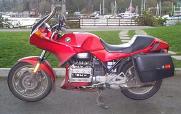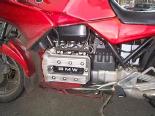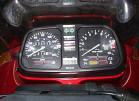1987 BMW K75s


Having turned in my R65 for a clutch replacement, I was given the K75s pictured here as a loaner. I figured I might as well continue on my grand tradition(?) and review this bike (with an eye towards comparisons to my R65, naturally) as well.
The K75s, as far as I can tell, was made with almost the same intent as the R65 LS. It's a small bike using the contemporary engine technology, aimed at sportier riders, and not caring much about full-on touring. It has a number of sportier features than other bikes in the line, without giving up the basic refinement and style of those bikes.
Since the K-bike line was intended to replace the Boxers entirely at the time this motorcycle was being designed, this makes sense as an R65 LS replacement.
The engine is a three-cylinder inline engine, much like a shrunk-down car engine. It uses fuel injection instead of carburation. From the clutch to the drive shaft is basically unchanged -- still a single plate clutch and nearly the same clunky gearbox. The brakes in front are remarkably similar to the R65 LS's, but the back is a much better disc brake. The frame is significantly different from the R65, with the engine forming a member of the frame, rather than resting inside it.

This engine is so very different from the engine on the R65. Instead of being a low-end-torque machine with a big flywheel, the K75 feels like it has no flywheel at all. When you twitch the throttle, the familiar sensation of torque pulling the bike to the right is absent.
When I first started the engine, I thought something might be wrong -- there was a high-pitched whine accompanying the "normal" engine noises that was very strange sounding. I knew beforehand that K-bikes whined, I just didn't think it was quite so prominent. The engine sound actually reminds me very distinctly of the Jetson's hovercars -- that high-pitched whining putt-putt is almost exactly the sound of this motorcycle accelerating slowly away in first gear.
Something about fuel-injected engines has always made me feel disconnected from how it all works. This remains true on the K75. Although it certainly does accelerate well. I think this engine has less low-end-torque than the R65 though, since I've killed it once when the R bike wouldn't have died, pulling into traffic (bad time to kill an engine, by the way).
Starting this engine is also much easier than on the R65, although I think that is to be expected. The "choke" lever isn't actually operating a choke so much as a fast-idle cam on the injector controller. Once it's started, the engine idles smoothly.

The path taken by the engine power, getting from the engine to the wheel, is essentially the same as on my R65. The clutch on this bike feels much crisper (although perhaps my clutch will feel the same way after its replacement) than the R65, and the gearbox feels slightly improved. The one "major" change that I've noticed is that the shift lever now stops in the middle position after you've hit first gear (you can't press it down any more). This makes it a bit more obvious when you've gone all the way down.
The gearbox is still fairly notchy, with plenty of opportunities (or so it seems) to find false neutrals. I haven't actually found any yet, so I may be misinterpreting the catch I feel halfway through the throw. Downshifting feels a bit more positive though.
The first thing I noticed about the brakes on this bike was the fact that the rear brake actually does something. Unlike on the R65, I can actually slow down the entire machine with the rear brake on the K75. The front brakes feel sort of weak by comparison, but I can't tell if that's due to the rear brake being so powerful, or if it's that they're actually weaker than I'm used to. Perhaps "less bite" might better describe the front brakes -- I know they'll stop the bike quite well, you just have to be more aggressive to do it.
The K75s uses the Monolever rear suspension, which basically means you get one swingarm going back instead of two. It also means that you have one shock and one spring in the rear -- on the particular bike I'm borrowing, the stock shock has been replaced with an Ohlins shock with a remote reservoir. I can't really comment on the Ohlins shock, as I won't have time to adjust it properly.
The front suspension is almost exactly the same as on the R65 -- a hydraulic fork with a spring in each leg. The springs on this motorcycle are stiffer than the R65, which is pretty nice for regular riding, but could be improved for going over big bumps.

The dashboard on this bike is one of the areas of greatest improvement, to me. (Well, ok, the engine is pretty significant, but I'm more thinking of things that are comparable between the two bikes.) It has the speedometer and tachometer as you'd expect, but it has two additions that I really like: a clock, and an indicator that shows which gear you're in. The clock is pretty much standard issue, as far as I can tell, but it's a very welcome change from the R65's dash. The gear indicator is a little single-digit LCD display in the lower right corner of the tachometer -- but what a nice thing! Perhaps I'm just showing my neophyte preferences, but I really like having an indication of what gear I'm in, rather than having to calculate RPM vs. speed, or keep the current gear in mind for a whole trip. Especially with the quieter engine, it's very nice to have.
The downside of the dashboard is that (at least on the example I have) it's not attached very well. Going over bumps would be humorous, except that I'm worried the instrument cluster is going to fall off. It wobbles back and forth and makes disconcerting noises. This hasn't apparently had a negative effect on the function of the instruments, but that can't go on forever.
The K75s I rode was a pretty nice bike. It clearly had felt its 38,000 miles, but it wasn't especially worn out. It wasn't as quick to steer as the R65, and was a little bit top heavy, comparatively. Its engine is clearly superior from a riding standpoint. From a service standpoint, I'll stick with the old Boxer.
Although I know this is a personal thing, I found the fixed fairing and instruments were quite disconcerting -- it felt as though the wheel wasn't moving, and starting into a turn (turning from a driveway onto a street for instance) was difficult. With the fairing and such all pointed straight ahead, I was unable to overcome the fear that the wheel was pointed straight ahead as well.
This bike also reaffirmed by dislike for regular mirrors -- bar-end mirrors are far superior for me. Perhaps I'm too wide or something, but regular mirrors either show me what's 45 degrees behind me, or my arms. Neither is particularly useful when trying to determine if there's a truck with no brakes screaming towards me at a stop sign. Bar-end mirrors, on the other hand, are wide enough to show what's actually behind me. I'm sure this is a matter of personal taste, though.
The seating position on the K75s surprised me. I had thought I was stretched forward on the R65 LS; boy was I wrong! The K75 had the handlebars placed at least an inch forward, perhaps more, so that I was approaching the sport-bike tuck. Getting on the R65 afterwards, I realized that the K75 felt about a foot longer in front, mostly due to the longer reach to the bars, and the fairing, which thrusts forward from the bars.
The term "Boxer" refers to an engine style where a pair of cylinders are horizontally opposed to each other -- if you look at the two cylinders from the top, they're almost on the same line, on either side of the engine. When they fire, they do so on opposite strokes, but both cylinders move in towards the crankshaft and out away from the crankshaft at the same time. The result, at least in theory, is a vibrationless engine.
When someone says a shifter feels notchy, they mean that there's not a silky smooth feeling when moving the shift lever from one gear to another. It feels almost like there are "notches" you have to move the lever past in order to make a complete transition from one gear to another. Usually, if you stop when you hit one of those notches, you'll find a false neutral.
A motorcycle transmission usually has 4 or five gears, plus a designated "neutral" -- a position in which the transmission doesn't power the rear wheel. This neutral is usually found between first and second gear. When you find a false neutral, you've shifted the transmission so that the gears aren't properly engaged, and it feels like you're in neutral again: the wheel's not receiving any power from the engine. However, this happens between gears other than first and second, which is bad. It usually means that gears and engaging levers are spinning with sub-millimeter clearance between them, probably doing Bad Things to the transmission. This is usually the result of hitting a particularly notchy transition between gears.
Bar-end mirrors are a style of mirror (arguably the most famous is the Napoleon brand) which attaches to the end of a bike's handlebars, just like the name suggests. The mirror is thus placed further out board than anything else on the bike (unless you've got huge saddlebags attached), and usually means you can see what's actually behind you, like with a car's mirrors.
Created by Ian Johnston. Questions? Please mail me.